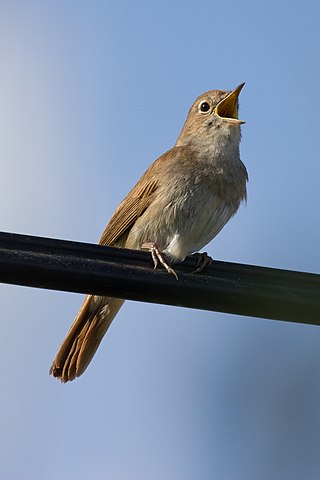
The thrush nightingale, also known as the sprosser, is a small passerine bird that was formerly classed as a member of the thrush family Turdidae, but is now more generally considered to be an Old World flycatcher, Muscicapidae. It, and similar small European species, are often called chats.

The common nightingale, rufous nightingale or simply nightingale, is a small passerine bird which is best known for its powerful and beautiful song. It was formerly classed as a member of the thrush family Turdidae, but is now more generally considered to be an Old World flycatcher, Muscicapidae. It belongs to a group of more terrestrial species, often called chats.
The Serravallian is, in the geologic timescale, an age or a stage in the middle Miocene Epoch/Series, which spans the time between 13.82 Ma and 11.63 Ma. The Serravallian follows the Langhian and is followed by the Tortonian.

Luscinia is a genus of smallish passerine birds, containing the nightingales and relatives. Formerly classed as members of the thrush family Turdidae, they are now considered to be Old World flycatchers (Muscicapidae) of the chat subfamily (Saxicolinae). The chats are a lineage of Old World flycatchers that has evolved convergently to thrushes.
Carduelis parvulus is an extinct species of Carduelis that inhabited Hungary during the Neogene period.
Carduelis lambrechti is an extinct species of Carduelis that inhabited Hungary during the Neogene period.
Saxicola baranensis is an extinct species of Saxicola that inhabited Hungary during the Neogene period.
Calandrella gali is an extinct species of Calandrella that inhabited Hungary during the Neogene period.
Erithacus minor is an extinct species of Erithacus that inhabited Hungary during the Neogene period.
Luscinia pliocaenica is an extinct species of Luscinia that inhabited Hungary during the Neogene period.
Lanius intermedius is an extinct species of Lanius that inhabited Hungary during the Neogene period.
Lullula minor is an extinct species of Lullula that inhabited Hungary during the Neogene period.
Monticola pongraczi is an extinct species of Monticola that inhabited Hungary during the Neogene period.
Riparia minor is an extinct species of Riparia that inhabited Hungary during the Neogene period.
Passer pannonicus is an extinct species of Passer that inhabited Hungary during the Neogene period.
Phylloscopus pliocaenicus is an extinct species of Phylloscopus that inhabited Hungary during the Neogene period.
Emberiza pannonica is an extinct species of Emberiza that inhabited Hungary during the Neogene period.
Emberiza parva is an extinct species of Emberiza that inhabited Hungary during the Neogene period.
Delichon polgardiensis is an extinct species of Delichon that inhabited Hungary during the Neogene period.
Cettia janossyi is an extinct species of Cettia that inhabited Hungary during the Neogene period.


